#Mount St. Helens eruption documentaries
Text
Random Headcanon #7
Nations can be affected by natural disasters, ranging from mild flulike symptoms, to being completely incapacitated. Some disasters can even result in permanent scarring, like a volcanic eruption or wildfires.
#hetalia#aph#hws#tw injury#tw scarring#tw illness#this has probably already been thought of#but#i was watching a documentary about the mount st helens eruption#and this came to mind#hetalia headcanons
11 notes
·
View notes
Text
Rock Swag Tournament Round 1: Igneous Rocks Part 11
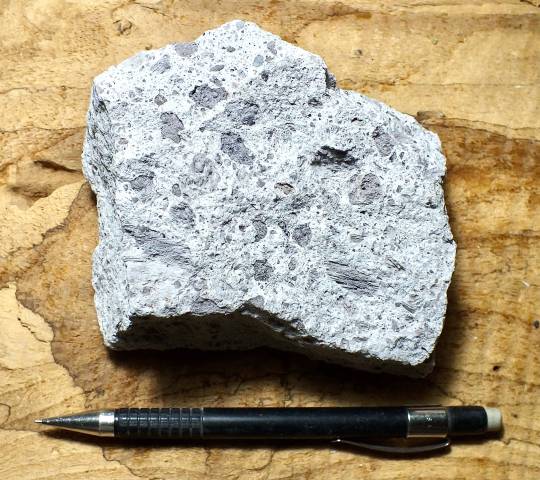

Tuff is an igneous rock...or maybe a sedimentary rock based on who you ask! It is made of lithified volcanic ash (lithification is the process by which particles of stuff become rock, and volcanic ash is sand grain-sized pieces of ejected volcanic matter).

Tuff generally also has pieces of all kinds of other stuff, as well. As long as stuff that is 2 mm or smaller makes up 75% of the rock, it will be considered tuff. Anything less than 75% volcanic ash, and the rock is described as "tuffaceous."
Fun fact: the Moai on Rapa Nui (Easter Island) are made of tuff! Also, according to one submitter, "this is one of the few volcanic rocks that can be made into a really lovely paint. Specifically a vaguely purplish gray" COOL!
Ignimbrite could be considered a type of tuff, but it is more specifically a rock formed from a pyroclastic flow deposit. Pyroclastic flows are one of the deadliest geological phenomena as they are burning hot clouds of gas and debris that race down the sides of volcanoes during some eruptions!
Ignimbrites can have more and larger pieces of volcanic debris, but they could also simply be tuffs that have welded due to the high heat from an eruption. Ignimbrites also may contain fiamme, which are "flame-shaped" lapilli (volcanic tephra or debris between 2 and 64 mm big) that have been flattened or sheared during deposition.

More on pyroclastic flows under the cut, because they are fascinating in that they are dangerous and I must talk about them.
Pyroclastic flows are blisteringly hot and terrifyingly fast clouds of volcanic gas and assorted tephra: volcanic material that can include ash (particles less than 2 mm), lapilli (between 2 and 64 mm), and blocks and bombs (greater than 64 mm).
They flow (violently rocket) down the side of volcanoes after explosive eruptions. You generally don't have to worry about pyroclastic flows on Kīlauea any time soon because those eruptions are mostly lava flows (which you can usually outrun). However, some of the most famous volcanic eruptions from recorded human history--Mount St. Helens in 1980, Krakatoa in 1883, and Vesuvius in 79 CE--were accompanied by pyroclastic flows.
Pyroclastic flows can be triggered a number of ways. Some examples are lava domes collapsing and causing an avalanche of sorts, part of the volcano exploding or collapsing in one direction (like Mount St. Helens), or the plume of debris and gas that is shot vertically into the air during an eruption collapsing back down to the surface (like Mount Vesuvius).
There is no outrunning a pyroclastic flow. They flow down the side of volcanoes and across the surrounding landscape at typical speeds upwards of 80 km/h (50 mph), but they can reach speeds of several hundred km/h. These clouds of debris are also several hundred degrees Celsius. You do not survive a pyroclastic flow!
If you would like to see what one of these looks like, I have two videos. Please be warned that because pyroclastic flows are so deadly, one of these two videos discusses deaths related to a specific eruption.
This video is from a documentary (I do not know the name of the film) and the beginning shows the genesis of the pyroclastic flow: the lava dome collapses and causes an avalanche. The pyroclastic flow then moves along a stream valley and close to a nearby town. CW: This video mentions the number of deaths directly related to this eruption and pyroclastic flow. There is footage of a vehicle and a person fleeing the pyroclastic flow, but the town they are in is are far enough away that the pyroclastic flow does not reach their location, and they survive. The potentially triggering part of the video begins at 0:24.
This video shows a pyroclastic flow going into the ocean. CW: As far as I can see, there are no people or animals in the path of the pyroclastic flow in this video and so there are presumably no deaths associated with this eruption.
75 notes
·
View notes
Note
I know on your old blog you posted some Romerica headcanons: could we perchance have some more 👀
abso-fucking-lutely! you made me realize i hadn't ever reblogged the old post, which had been on my agenda. huzzah. once again crediting @temtamtom with so many of these. we are both insane when the blorbos exist. these are in no distinct order of importance or chronology.
When they're together, if they catch each other doing basically anything, they start to hear "Whatta Man" - or some period equivalent - playing in their heads.
Despite having met Sebastiano (Seborga) later than Ludwig, Alfred quickly became the favorite boyfriend after proving to a young Seb that he could, in fact, lift a rather large vehicle with his bare hands. Sebastiano was gobsmacked at learning such a rumor was true. On the other hand, Romano was ready to go nuts at learning they did this in public while Alfred was walking Sebastiano to school (during a visit to Italy in the mid-1970s).
While Romano no longer works for Alfred, he occasionally still calls him "capo" (boss) as a joke or term of endearment.
Alfred, as the Spotify owner, has snuck several tracks from their favorite westerns into their playlist. If listening to it while in one of their respective homes, they will find each other in the nearest room or hallway and have a finger gun showdown.
Their relationship started out professional and fairly closed, but as Romano grew more comfortable around his housemates in the US, they learned that he has quite a sense of humor. The first time Alfred and Tolys got to hear Romano truly laugh, Alfred wanted to hear it again. And boy, did he try, with decent success as the years went on. At that moment, Tolys was unwillingly signed up to be the therapist for both Romano and Alfred as they continuously dropped the ball on their fledgling crushes.
While not a professional pickpocket, Romano has great sleight of hand. It's his game with Alfred. He will swipe items from Alfred's person and see how long it takes for him to notice. His phone, wallet, a pen, sometimes his watch, anything small or loose. Romano's the Kitty Softpaws to Alfred's Puss in Boots. ((Or Antonio's, for those that enjoy SpaMano.))
Romano is the caution and wisdom through experience. Alfred is the ideas and impulse. Both may be smart, but if they were a criminal couple like Bonnie and Clyde, Alfred is the smash and Romano is the grab.
Romano's expertly crafted verbal thrashings and "he asked for no pickles" to Alfred's picking him up and carrying him away, "come on, let's go".
They have bonded over archaeology (Alfred) and volcanology (Romano), especially in sites such as Herculaneum, Pozzuoli, and Mount St. Helens. Also the eruption of Mount Vesuvius in March 1944; there are some really interesting images from the Liberation of Italy in WWII from this event. ((This headcanon was sponsored by the documentary Fire of Love.))
#callsign gremlin checking in#romerica // spaghetti western#alfred f. jones // daring to fly#romano de cesare // luctor et emergo#i'm sorry there aren't as many as last time#i was struggling to choose headcanons to share#hetalia#hetalia headcanons#aph america#aph south italy#hws america#hws south italy#romerica
75 notes
·
View notes
Text
i really want to learn about mount st helens, specifically regarding recovery of the area over the past 40 years, but every youtube documentary is like AH YES, THE WEEKS AFTER THE ERUPTION WHERE ASH BLANKETED THE REGION- no i want to know about the ecology like. today.
3 notes
·
View notes
Video
youtube
KOIN Vault: Mount St. Helens eruption documentary, July 1980
- Shared on the anniversary of the eruption.
0 notes
Text
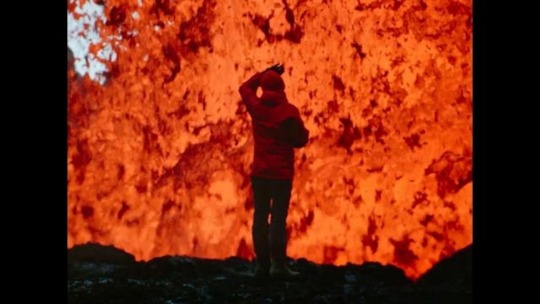
Katia Krafft shields her face from the intense heat as she watches a mass of molten rock from the ground. National Geographic
She Fell in Love With The Majesty of Volcanoes—and Changed How Science Sees Them
Katia Krafft traveled to volcanoes around the world to unlock their mysteries, capture their beauty, and raise awareness of their risks.
— By Maya Wei-Haas | January 09, 2023
Sheathed in a shiny metallic suit, Katia Krafft's small frame is dwarfed by the crimson curtain of molten rock that bursts from the ground before her. The dramatic moment was captured in a photo taken atop Iceland's Krafla volcano in 1984, during the fiery peak's final gasps of a multi-year-long eruption. Looking at the image, one can almost feel the volcano's heat, hear its roar, and sense Krafft's heart pounding as the volcanologist does what she loves most: bearing witness to our planet's fiery fury.
"Once you see an eruption, you can't live without it because it's so grandiose, it's so strong," Krafft says in the National Geographic documentary Fire of Love now streaming on Disney+.
Krafft was a fearless pioneer in volcanology, studying the explosive peaks at a time when there were few women in the field. The moment a volcano exploded, she and her husband, Maurice Krafft, also a volcanologist, dropped everything to analyze and capture the beauty and mystery of each event. These stunning close-ups allowed geologists to dissect the intricate details of each eruption like never before. The Kraffts wrote books, made movies, and embarked on media tours to share their knowledge with people around the world, raising awareness of volcanic risks.

"That was really still the infant days of volcanology," says Janine Krippner, a volcanologist based in New Zealand. For Krippner and many other women scientists worldwide, Katia, in particular, also helped spark their own desires to enter this field. "She gave me the courage to really push forward," says Krippner, who yearned to be a volcanologist since she first learned of the profession at age 13.
Explosive Entrance
Katia Krafft—Catherine Joséphine Conrad before marriage—was born in the Rhine valley of northeast France in 1942, during the height of World War II. The tumultuous human world drove both Katia and Maurice to seek comfort in nature. "We were disappointed in humanity," he once said. "Since a volcano is greater than man, we felt that was what we need—something beyond human understanding."
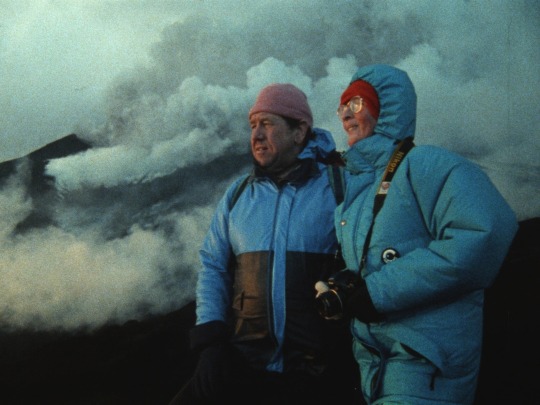
Katia and Maurice Krafft gaze at a volcano in the distance as plumes of ash, steam, and gasses billow behind them. Photograph By Image'est
Indeed, when the duo studied at the University of Strasbourg in the 1960s, little was known about the forces that drive our restless planet. Plate tectonics was just gaining acceptance. This foundational theory describes the dynamics of the fractured outer layer of our planet. Each tectonic plate is perpetually moving, colliding in some places and pulling apart in others, building volcanoes along their boundaries.
The Kraffts set out with little money and lots of determination to understand these mysterious geologic beasts, capturing stunning videos and imagery. In one, seen in the documentary, Katia calmly approaches a fountain of incandescent lava. Dressed in a red jacket and matching hat, she raises an arm to her face as a shield from the intense heat. Another snippet shows a lobe of gooey rock cooled just enough to form a black crust. A boot squishes the mound, igniting flames that the boot-wearer casually shakes away.
"Once you see an eruption, you can't live without it because it's so grandiose, it's so strong." — Katia Krafft
The pair initially focused their work on so-called effusive eruptions, in which lava streams from the volcano. While still dangerous, effusive eruptions are usually less deadly in comparison to their explosive relatives. But two deadly disasters led the Kraffts to turn their lenses on the devastating impacts of explosive blasts. In 1980 the eruption of Mount St. Helens in Washington killed 57 people, and in 1985, Colombia's Nevado del Ruiz unleashed a blast that triggered deadly mudflows that killed more than 20,000 people.
The Kraffts used their footage of explosive eruptions to explain the complex risks and uncertainties of these disasters. "It changed our ability to communicate volcano science," says volcanologist Rebecca Williams at the University of Hull, in England, who was a science advisor for Fire of Love.
Their videos are credited as one of the primary reasons that officials in the Philippines took the warning signs of Mount Pinatubo's eruption in 1991 seriously. Yet the Kraffts didn't live to see that eruption.
The couple died less than two weeks earlier in Japan during a monstrous eruption, which claimed 41 other lives.


Left: Katia smiles while wearing a metal helmet during work on Mount Etna in 1972. This oversized shell was intended to protect its wearer from falling rocks during active eruptions. Photograph By Image'est Right: Katia snapped this image that shows how lava can stretch into fine glass fibers called Pele’s Hair. National Geographic
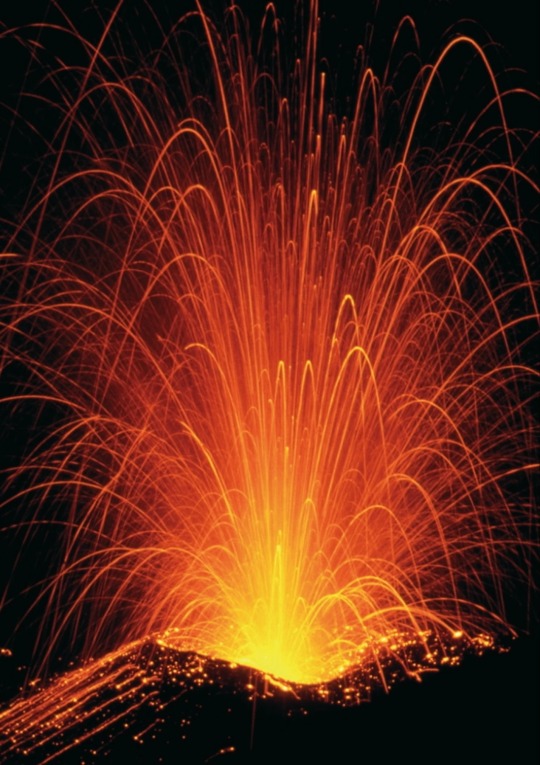
Katia and Maurice Krafft saw photography as way to remember, revisit, and stretch their time with volcanoes. This photo taken by Katia shows the parabolic trajectories of volcanic bombs ejected from Stromboli volcano in Italy. National Geographic
A Persisting Legacy
Katia's impact on volcanology has reached far beyond her death and has inspired many young women to study our restless planet. Today, 39 percent of the 937 members of the international volcanology society IAVCEI are women. Yet inequities still persist.
"There are medals that have never been given to a woman," says Williams, an author of a recent analysis of diversity in volcanology. "They're not being given the keynotes. They're not being given the awards." And all 22 of IAVCEI’s presidents have been men.
Men also continue to outnumber women in films and images of volcanologists. So seeing Katia in the field has motivated many budding geologists. "Katia Krafft is definitely the reason why I'm doing this job," says Carla Tiraboschi, a postdoctoral researcher at the University of Münster, Germany. Tiraboschi first saw Katia in a documentary when she was just six or seven years old and has been obsessed with volcanoes ever since. She now studies the processes at work deep below the fiery peaks.

Many volcanologists share these sentiments, including some whose paths briefly crossed Katia's. At age 16, Marie-Claude Williamson met Katia during an evening lecture where the Kraffts were narrating one of their films. Williamson was enthralled with the footage and timidly approached Katia to ask how one becomes a volcanologist. "By pursuing a career in geology, of course!" she recalls the terse reply in French.
Williamson is now a research scientist at the Geological Survey of Canada. "It was largely the vision of the extraordinary woman I briefly encountered when I was 16 that kept me going," she says.
1 note
·
View note
Text
On the 42nd anniversary of the Mount St. Helens disaster, a review and A+ documentaries
On the 42nd anniversary of the Mount St. Helens disaster, a review and A+ documentaries
I like to read nonfiction, and I’ll confess, there is much of it that isn’t an easy read, even if I’m riveted by the topic. Steve Olson’s Eruption: The Untold Story of Mount St. Helens, however, is an exception, and on the 42nd anniversary of that fateful 1980 day, I can’t recommend it highly enough.
My copy of ERUPTION is tied with a ribbon because I have articles all stuffed inside it. It sits…
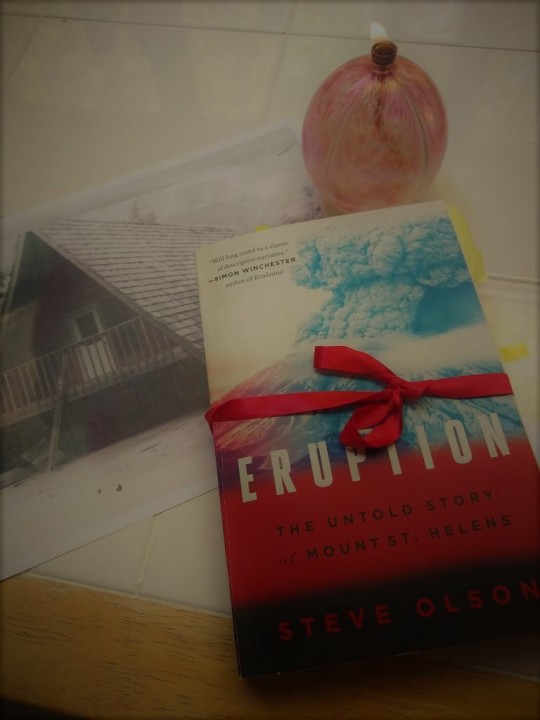
View On WordPress
#1980#Eruption#MountStHelens#MtStHelens#Volcano#WashingtonHistory#WashingtonState#book review Steve Olson’s Eruption#Geology#Mount St. Helens eruption 1980#Mount St. Helens eruption documentaries#personal accounts of Mount St. Helens eruption
1 note
·
View note
Text

CIA Reconnaissance Photo of Mount Saint Helens 7/22/1980. NARA ID 595259.
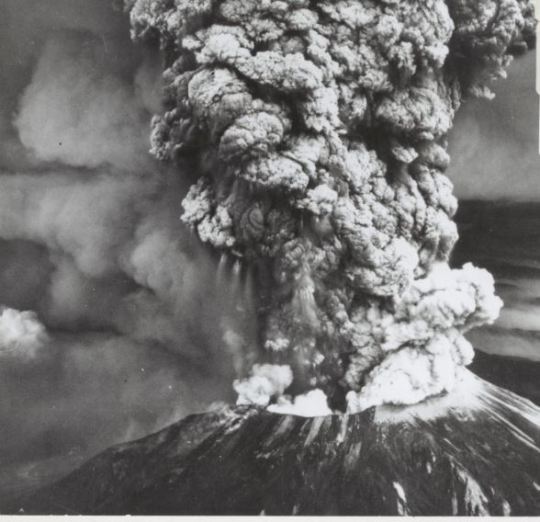
Mount St. Helens Eruption, 5/18/1980, USDA Forest Service, NARA ID 7035237.
#OTD 1980: Mt. St. Helens Erupts
By Miriam Kleiman, Public Affairs
Mount St. Helens erupted for nine hours on May 18, 1980, destroying plant and animal life in the surrounding 230 square miles of forest and killing 57 people. The blast of ash, rock, and steam blew across the Gifford Pinchot National Forest at speeds up to 670 MPH, with the ash plume reaching 15 miles upwards. Our holdings include Forest Service records documenting this eruption and its aftermath.
Eruption was bad, but not as bad as Mt. Vesuvius...
This record puts this eruption in historical perspective:

USDA records of the US Forest Service, May 1980. NARA ID 7035237
Eruption was bad, but there's hope:
Gov't film offers perspective and reassurance (emphasis added):
This Place in Time: The Mount St. Helen's Story "Recounts through reenactments, personal recollections, and documentary narration, the earth-changing event and aftermath of the May 18, 1980, volcanic eruption of Mount St. Helens... The film leaves the viewer with a positive feeling that the devastated area will someday be beautiful again during the course of the earth-shattering and earth-healing process."
youtube
This place in time: The Mount St. Helens story 1984 (USDA, Forest Service, NARA ID 13504)
Before-and-after photos show the eruption's impact:
BEFORE:
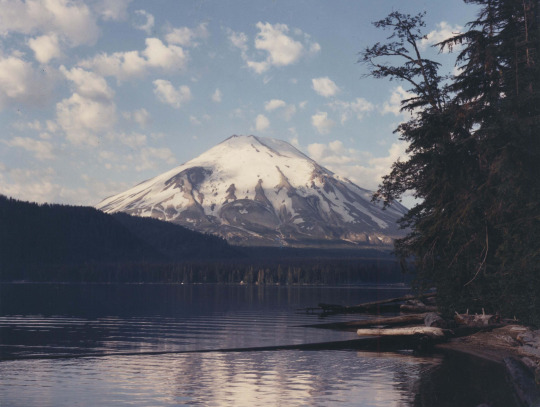
Mount St. Helens and Spirit Lake, 1936. USDA Forest Service, NARA ID 6017991.
AFTER:

Spirit Lake buried by debris, 5/19/1960, USDA, Forest Service, NARA ID 6017993.
The National Archives holds these and many more records in Record Group 95 - Records of the Forest Service - approximately 38 million pages of textual records alone. You can find nearly 300 million textual scans in our Online Catalog.
Related National Archives Text Message blog posts:
Timber! Picking the Perfect Christmas Tree
Righting a Wrong: The Return of Blue Lake to the Taos Pueblo
Growing Pains: Army Air Service Patrols of National Forests, 1919-1920
T.V. Pearson and the Parachute Scheme
#volcanoes#mt st helens#mountsainthelens#natural disasters#otd#washington state#forest service#uSDA#wildlife
248 notes
·
View notes
Text
I was watching a documentary on the 1980 eruption of Mount St. Helens last night and it was one of the most catastrophic natural disasters ever. It caused the largest landslide in history up to that point with blasts that were equivalent to 500 Hiroshima bombings, killed dozens of people, led to flooding that took out entire bridges and houses, and spewed enough ash to reach 12 states.
Yet there was still footage of people who insisted that no one could tell them not to get near the volcano because something something taxpayer dollars something something FREEDOM and government couldn’t tell them to do ANYTHING. They had a RIGHT to endanger themselves and all the first responders who were sent in after them because AMERICA.
So yeah, these people have always existed. There may be more of them now thanks to the internet and an administration that emboldens them, but they have always been around. And they’re every bit as stupid and selfish now as they were then.
7 notes
·
View notes
Text
god, everytime i watch documentaries on the mount st helens eruption,,,, hearing "Vancouver! Vancouver! This is it!" always gives me fuckin chills all over my entire body
3 notes
·
View notes
Text
Archaeology: 'Mass grave' was buried under volcanic ash 1000 miles from eruption | Science | News
Archaeology: ‘Mass grave’ was buried under volcanic ash 1000 miles from eruption | Science | News
Yellowstone volcano’s magma chamber mapped in documentary
Yellowstone supervolcano has been the source of intense research by scientists for many decades. It has blown its top three times in history in what have been described as “supereruptions”: eruptions that are approximately 1,000 times more powerful than the Mount St Helens eruption of 1980 which is often considered the most disastrous…

View On WordPress
0 notes
Link
Yellowstone volcano warning over 'largest and most devastating eruption in history' Yellowstone eruption would be ‘devastating’ says Oppenheimer The supervolcano gets its nickname due to its ability to inflict global devastation during a supereruption, something that has happened three times in the past – 2.1 million years ago, 1.3 million years ago and 640,000 years ago. The latest event of this kind, which created the Lava Creek Tuff, saw more than 630 miles of rock and volcanic ash ejected into the sky and caused devastation on a grand level. But even that would pale in comparison to the destructive power of a future flood basalt event. This series of volcanic eruptions – lasting for thousands of years – could threaten life as we know it, YouTube channel ‘Facts in Motion’ revealed in their ‘The Most Dangerous Type of Eruptions’ documentary. The narrator said: “What was the most devastating volcanic eruption in history? Maybe volcanoes like Mount St Helens, Krakatau, or Mount Vesuvius come to mind. “After all, there is a reason these names are remembered till today, decades, centuries and even millennia after their most famous eruptions. “The eruption of Mount St Helens killed over 50 people and caused over $1billion (£710million) in damages. Yellowstone volcano poses a significant threat (Image: GETTY) Yellowstone experienced a supereruption 640,000 years ago (Image: GETTY) “Mount Vesuvius famously killed at least 1,000 people from Pompeii and three other Roman cities. “And the catastrophic eruption of Krakatau killed at least 36,000 people, but there are of course volcanic eruptions that are still considerably worse.” But the series went on to reveal why flood basalt eruptions pose more of a threat. It added: “Supervolcanoes like the one beneath Yellowstone National Park for instance which last erupted 630.000 years ago. “This eruption was in terms of material ejected around 50 times larger than Krakatau. READ MORE: NASA study to ‘save world’ from Yellowstone eruption sparked warning: ‘Could be too late’ Flood basalt eruptions have also struck the planet (Image: GETTY) “But even that is minuscule compared to what our planet is capable of at its worst. “This is a flood basalt eruption. Even though their name might not suggest it, they are the largest and most devastating lava eruptions in history. “Eruptions so massive they have again and again changed life on this planet in a way and on a scale like no other natural phenomenon.“ Many flood basalts have been attributed to the onset of a hotspot reaching the surface of the Earth via a mantle plume. And the documentary detailed the chilling implications they can have. It added: “To understand how enormous these eruptions were and what impact they had on Earth and its inhabitants, we have to go on a journey into the past. DON’T MISSYellowstone volcano: How USGS study showed ‘abnormal’ change [REVEALED]Yellowstone: How scientists made alarming find in lake [COMMENT]Yellowstone volcano shock: Eruption mantle runs under California [STUDY] Yellowstone volcano is constantly monitored (Image: GETTY) “Let me take you back in time 252 million years, to the Late Permian Period – roughly 10 million years before the appearance of the first dinosaurs. “At that time all the continental plates were fused into one gigantic supercontinent called Pangea. “This was the scene of the biggest natural disasters in history – a key event that would alter the planet on such a scale it would forever change the course of evolution.” The Siberian Traps is a large region of volcanic rock in Siberia, Russia and is one of the largest known volcanic events in the last 500 million years. And the series explained how the event unfolded. It continued: “Around 252 million years ago an unimaginable amount of molten rock, risen from inside the Earth, had accumulated directly beneath the crust and was now at various points beginning to make its way to the surface. “ “The widespread release of gas from the ground, major and continuous earthquakes as well as the uprising of the crust by several hundred meters were signs of the impending catastrophe. “It probably started in the north-west of Siberia in the Tunguska Basin, near today’s city of Norilsk. “Over an area of more than 40,000 miles, a vast network of volcanic events began to open producing huge pyroclastic and phreatomagmatic eruptions with fire fountains 20-miles-high and spreading enormous quantities of gas, molten rock and ash across the lands.” Over the years, there have been many unsupported claims that Yellowstone is “overdue” an eruption, after the average time between such events were calculated. USGS say the volcano is not overdue an eruption (Image: GETTY) But Dr Mike Poland suggested the hotspot may be in a state of decline during the USGS’s recent update on their YouTube channel. He said: “The magma chamber beneath Yellowstone is only about five to 15 percent molten, so it doesn’t have enough to generate one of these big explosions. “Over the last 15,000 years or so, since the last Ice Age, we know from the geology of Yellowstone Lake that Yellowstone has mostly gone down. “In fact, it’s gone down by a net of 30 metres, almost 100 feet, over that time period, so there’s no pressure and there’s really no magma to feed one of these really big explosions.” if(typeof utag_data.ads.fb_pixel!=="undefined"&&utag_data.ads.fb_pixel==!0)!function(f,b,e,v,n,t,s)if(f.fbq)return;n=f.fbq=function()n.callMethod?n.callMethod.apply(n,arguments):n.queue.push(arguments);if(!f._fbq)f._fbq=n;n.push=n;n.loaded=!0;n.version='2.0';n.queue=[];t=b.createElement(e);t.async=!0;t.src=v;s=b.getElementsByTagName(e)[0];s.parentNode.insertBefore(t,s)(window,document,'script','https://connect.facebook.net/en_US/fbevents.js');fbq('init','568781449942811');fbq('track','PageView') Source link Orbem News #Devastating #eruption #history #largest #volcano #warning #Yellowstone
0 notes
Note
5 and 24 for the writer asks mellybean (tell me about them hot rocks)
mellybean omg I'm in love. 😍
5. Character you were most surprised to end up writing.
god, you're gonna make me admit this 😐
okay, so first it was Z*ke of course cause he legit made me scream in the manga. just wanna slap his face. so when I started writing him as a toxic ex in an old fic and, like... enjoyed it, I was surprised. and disappointed 😂
but now... oh, man. the way that I already have two full fics planned for Levi after already writing one... it's wild. never thought I'd see the day.
24. Have you ever become an expert on something you previously knew nothing about in order to better a scene or story?
okay you already know. expert is a strong word, but I researched so much for Pyro. like watched a BBC movie about what would happen if it ever erupted. watched a documentary on Mount St. Helens then another just on various volcanoes around the world (this is how I learned about Maurice and Katia Krafft). I had the USGS website open on my laptop and phone the whole time I was writing it.
So yeah, I gathered... quite a bit of knowledge while writing it lol
fanfic asks 💕
2 notes
·
View notes
Video
youtube
This is an archive video which recounts the Mount St. Helens volcanic eruption through reenactments, personal recollections, and documentary narration, the earth-changing event and aftermath of the May 18, 1980, Mount Saint Helens eruption in the Gifford Pinchot National Forest of southwest Washington. The film represents the work of dozens of both professional and amateur cinematographers and still-photographers in doumenting the dramatic eruption of the volcano at Mount St Helens. We hope you enjoyed this video, don't forget to hit the thumbs up if you liked it and subscribe! #MountSaintHelensVolcano #MountStHelensVolcano #Volcano
0 notes
Text
Mount St Helens WARNING: Scientist reveals molten rock 'rising FIVE metres a DAY' | Science | News | Express.co.uk
Mount St Helens WARNING: Scientist reveals molten rock ‘rising FIVE metres a DAY’ | Science | News | Express.co.uk
Mount St Helens WARNING: Scientist reveals molten rock ‘rising FIVE metres a DAY’MOUNT St Helens could erupt again as scientists closely monitor a lava dome rising at five metres a day, a bombshell documentary revealed.
Source: Mount St Helens WARNING: Scientist reveals molten rock ‘rising FIVE metres a DAY’ | Science | News | Express.co.uk
View On WordPress
0 notes
Text
Geophysicist gives chilling warning over the Yellowstone volcano
(Express) – Robert Smith is a leading lecturer at the University of Utah, who has years of experience in natural disasters, including his study into Yellowstone. The supervolcano, located in Yellowstone National Park, has erupted three times in history, 2.1 million years ago, 1.2 million years ago and 640,000 years ago. However, a fourth eruption could have dire consequences, according to Dr. Smith. He revealed during a 2015 BBC documentary titled “Supervolcano” how another eruption could prove fatal to
humanity. He said: “If another eruption was to occur, I think there is little man can do about it. “The biggest thing we can do now understands them.” The last eruption of Yellowstone produced around 2,500 times more volcanic material than the 1980 eruption of Mount St Helens. Geologists have warned, once a triggering event takes place, an eruption could happen in as little as two weeks. READ MORE
0 notes